Physical Address
304 North Cardinal St.
Dorchester Center, MA 02124
Wear of the bearing surface is a major factor in the service life of total hip and surface replacements.
The hip bearing constitutes a tribological system; thus, wear is a system property impacted by multiple variables, such as bearing dimensions, anatomic placement, bearing materials, loading conditions, joint motion, and lubricant.
Various bearing couples with different wear properties are available. A cobalt-chromium-molybdenum (Co-Cr-Mo) and ceramic femoral head articulating against a highly cross-linked ultra-high-molecular weight polyethylene (XLPE) acetabular component are the most common bearing surfaces used today.
Wear testing of hip bearings is necessary to assess materials and geometries preclinically following American Society for Testing and Materials (ASTM) and International Organization for Standardization (ISO) standards.
Although wear has significantly decreased with the use of XLPE liners, it is important to try to reduce wear and its effect on host tissues because total hip arthroplasty (THA) is often performed on young patients.
Tribology is the science and technology of interacting surfaces in relative motion. It includes the study and application of the principles of friction, wear, and lubrication. Friction is a natural phenomenon in our daily lives, causing wear of bodies in contact. Although Leonardo da Vinci (1452–1519) and Guillaume Amontons (1663–1705) recognized and formulated the basic principles of friction, the underlying mechanisms of friction and wear are poorly understood. Lubrication between contacting bodies reduces detrimental consequences of friction and wear. In this chapter, we present the current understanding of tribology in the context of prosthetic wear, with a focus on hip implants. However, many of the principles also apply to other articulating joint replacements.
In hip replacement, wear and the consequences of wear continue to be an important cause of implant failure. Billions of wear particles generated annually can migrate to the periprosthetic tissues, causing localized chronic inflammation and resorption of bone adjacent to the implant. This mechanism, called osteolysis , may lead to subsequent implant loosening and failure and is discussed in detail in later chapters.
Because of the biologic complications of wear debris, it is important to identify precise and purposeful measures for wear reduction. Knowledge of the multifactorial nature of wear and accurate modeling of in vivo conditions within the laboratory allow us to overcome the simple trial-and-error methods of the past and help reduce risks for the patient. Therefore it is essential to analyze surfaces that have been worn under the actual “operating conditions” to learn about the influencing factors of the system and replicate them satisfactorily in a bench test.
This chapter covers the major aspects of tribology related to the articulating surfaces of hip prostheses. First, the definitions of terms associated with a tribological system are given, with particular emphasis on wear mechanisms, wear modes, and lubrication regimes. The hip bearing is then presented as a tribological system, with specific wear modes and mechanisms, outputs (material loss, heat, and sometimes sound), and lubrication regimes. The wear characteristics of hip bearing couples as a function of geometry and bearing materials are discussed. This is followed by a section on wear testing procedures, covering screening tests for materials and full-fledged tests of hip bearings in simulators. The chapter ends with a list of current concerns and future directions, which include uncertainties regarding the long-term wear behavior of highly cross-linked polyethylenes (XLPEs), improving wear of metal-on-metal bearings, developing new materials and coatings for bearing surfaces, improving wear testing of prosthetic hip joints, and developing virtual wear testing that would complement actual wear testing.
A tribosystem consists of four elements: a body, a counterbody, an interfacial medium, and an environment ( Fig. 3.1 ). The relative kinematics of the bodies, the contact load and loading profile, and the ambient temperature define the input variables of the system. The mechanical function of motion with load bearing that characterizes every tribosystem is always accompanied by some loss of energy, mostly in the form of heat (≈ 90% of the introduced energy), sound, and wear. The loss of material that constitutes the wear component is influenced by many factors, including general bulk properties of the articulating bodies; their surface characteristics (e.g., roughness, hardness, surface energy); and system conditions, such as the lubricant, relative motion of the bodies, and loads transmitted.
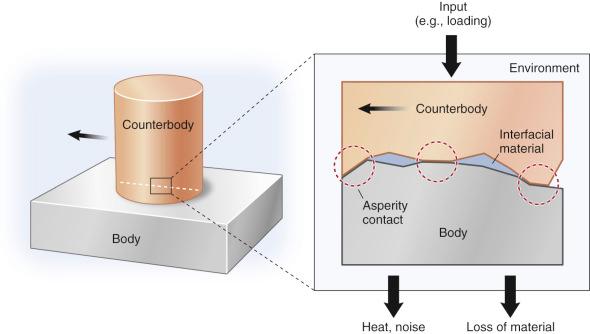
Knowledge of the contact conditions between interacting bodies is important for the understanding of wear mechanisms. On the microscopic level, all surfaces have an intrinsic roughness, even those that appear perfectly smooth (see Fig. 3.1 ). Hence, contact between articulating surfaces is established only on asperities, yielding many tiny contact spots, so that the real contact area is significantly smaller than the apparent contact area ( Fig. 3.2 ). This distinction between real and apparent contact areas is a key concept in tribology. During motion, these tiny contact locations are deformed elastically and/or plastically within a chemically challenging environment. Particles are then created by mechanically or chemically dominated wear mechanisms.
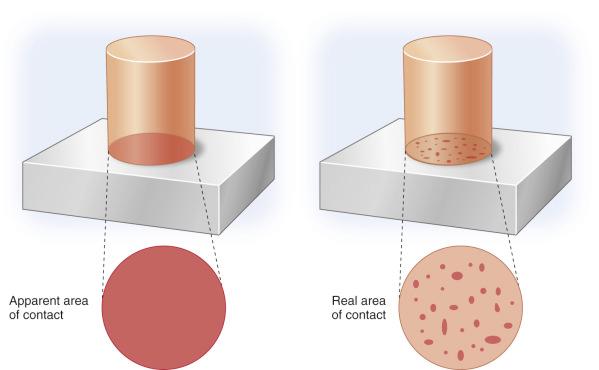
Currently, 4 major wear mechanisms are known and distinguished: (1) abrasion ; (2) surface fatigue , which involves microscopic crack initiation and propagation; (3) adhesion ; and (4) tribochemical reactions , which involve primarily chemical processes ( Box 3.1 ). Depending on the chemical reactivity of the bearing material, chemical bonding between articulating materials (adhesion) or with surrounding agents (tribochemical reaction) can occur. In simulating the wear of hip prostheses within the laboratory, it is essential to replicate the in vivo wear mechanisms, not just the observed wear rates (the wear loss per cycle or unit time). Key validity indicators of laboratory simulations include the surface appearance and morphology of the worn surfaces, which must resemble those of explanted components, and the shapes, size distributions, and chemistry of wear particles generated during testing, which must duplicate those collected from periprosthetic fluid and tissue.
Mechanical cutting or plowing process
Induced by asperities of the counterbody, foreign particles (contaminants from outside the wear system [e.g., bone cement] or particles generated within the system itself [e.g., fractured carbides, wear debris])
Four different submechanisms of abrasion exist, depending on the properties of the bodies in contact: microplowing, microcutting, microcracking, and microfatigue, reflecting the cyclical elastic and/or plastic nature of the contact.
Repeated sliding or rolling over the same wear track
Initiation and propagation of microcracks parallel and orthogonal to the bearing surfaces for mechanical or material-related reasons
Wear appearance: shallow pits and delaminations
Materials from both surfaces adhere to each other (similar to friction welding).
During mechanical action, these microjunctions are torn off and fragments become particles that are transferred from body to counterbody (and vice versa).
Wear appearance: adhering material flakes and pits. In severe cases, generated flakes and particles act abrasively, leaving severe scratches and grooves behind. The latter may cause joint seizure.
Surfaces in mechanical contact become activated and react with the interfacial medium and/or environment.
Results in the alternating formation and removal of reaction products at the surfaces, which change the material characteristics of the surface.
Wear appearance: often microscopically visible as a patchy layer
The wear mode is the particular dynamic configuration of body, counterbody, lubricant, and environment that generates wear in the tribosystem. Common wear modes include sliding wear, rolling wear, and third-body abrasive wear ( Fig. 3.3 ). In the hip, for example, wear between the head and cup occurs from sliding wear. In the presence of bone cement particles, the wear mode shifts to third-body abrasive wear. These two modes trigger profoundly different wear mechanisms; thus, they generate different types and amounts of wear. A wear mode is not a steady-state condition, and a shift between modes can occur. For example, worn carbides generated from metal-on-metal sliding wear between cobalt alloy surfaces can change the wear mode to third-body abrasion, as the carbide particles released from the bearing surfaces actively participate in the tribological process. Each wear mechanism generates a characteristic wear appearance , also known as a wear pattern or wear damage , observed through visible changes in surface structure (texture and shape) that occur as a consequence of wear ( Fig. 3.4 ).
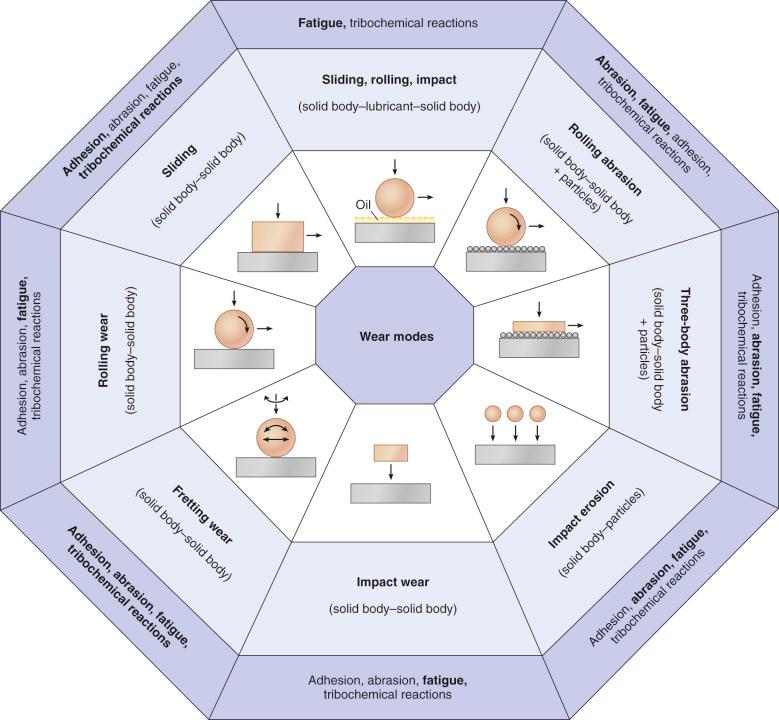
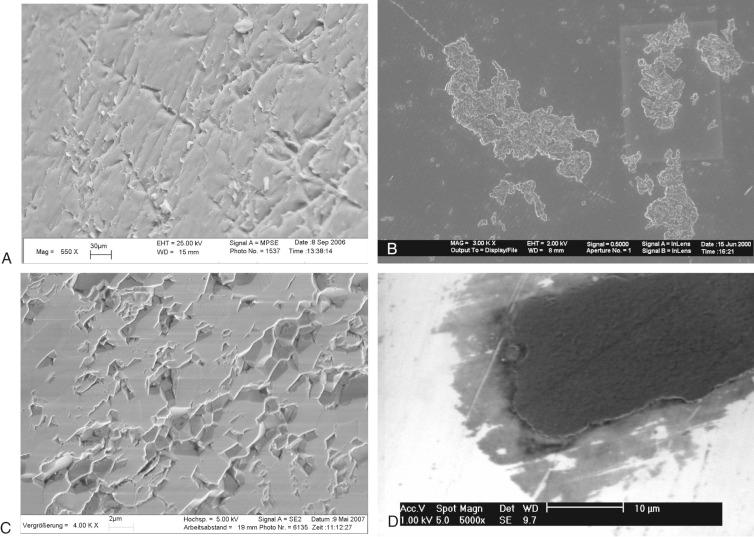
Friction is the introduction, transformation, and dissipation of energy. Surface asperities become elastically and/or plastically deformed when they come in contact (or interlock) with asperities of the countersurface (see Fig. 3.1 ). Another contribution comes from the adhesion of surface atoms and molecules of the body and counterbody.
Lubrication can reduce friction and wear. Both deformation and adhesion contributions to friction can be significantly reduced by lubrication. The extent of fluid film formation plays an important role in the wear process of joint replacements, as has been described for technical bearings using the Reynolds equation , derived from the general Navier-Stokes equations for laminar fluid flow. Stribeck developed the groundwork for a quantity known as the lambda ratio (λ), which is the thickness of the lubricating fluid film relative to the surface roughness of the contacting materials. The higher the value of λ, the greater the fluid film thickness relative to the height of the asperities. The value of λ increases with the viscosity of the lubricant and the sliding velocity, and decreases with the load on the interface and the roughness of the mating surfaces. The value of λ also depends on the local gap geometry, because formation of a fluid film during sliding motion requires that the mating surfaces form a convergent gap (i.e., a slight wedge). During sliding, the fluid is entrained into the wider end of the wedge and gets partially trapped, forming a pressurized film that supports load. In a hip bearing, slight differences between the head and cup radii naturally produce such a convergent gap. The λ ratio is used to estimate the occurrence of 3 distinct lubrication regimes ( Fig. 3.5 ): (1) λ < 1, a region of boundary lubrication in which the asperities of the 2 articulating surfaces are in contact and the lubricant reduces resistance to relative motion between counterfaces by chemical and physical processes; (2) 1 < λ < 3, a region of mixed lubrication in which parts of the surfaces are separated by the lubricant but isolated surface points remain in contact; and (3) λ > 3, a region of hydrodynamic lubrication in which a full fluid film covers the asperities, completely separating the articulating surfaces. Although the friction coefficient is relatively low in this region, it increases with film thickness because the ability of the film to support load (F N ) decreases faster than the corresponding reduction in viscous drag (F T ). Thus, the friction coefficient, which equals F T /F N , increases. In the mixed lubrication regime, the importance of well-polished surfaces is apparent: the higher a single large asperity protrudes through the lubricating film, the longer it will remain in contact with the other surface.
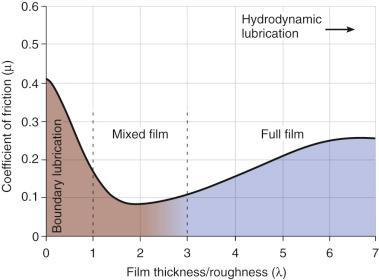
Become a Clinical Tree membership for Full access and enjoy Unlimited articles
If you are a member. Log in here